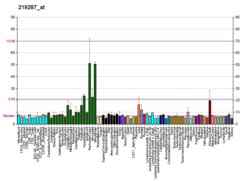Calcium-activated potassium channel subunit beta-4 is a protein that in humans is encoded by the KCNMB4 gene .[ 5] [ 6] [ 7]
MaxiK channels are large conductance, voltage and calcium-sensitive potassium channels which are fundamental to the control of smooth muscle tone and neuronal excitability. MaxiK channels can be formed by 2 subunits: the pore-forming alpha subunit and the modulatory beta subunit. The protein encoded by this gene is an auxiliary beta subunit which slows activation kinetics, leads to steeper calcium sensitivity, and shifts the voltage range of current activation to more negative potentials than does the beta 1 subunit.[ 7]
^ a b c GRCh38: Ensembl release 89: ENSG00000135643 – Ensembl , May 2017^ a b c GRCm38: Ensembl release 89: ENSMUSG00000054934 – Ensembl , May 2017^ "Human PubMed Reference:" . National Center for Biotechnology Information, U.S. National Library of Medicine .^ "Mouse PubMed Reference:" . National Center for Biotechnology Information, U.S. National Library of Medicine .^ Brenner R, Jegla TJ, Wickenden A, Liu Y, Aldrich RW (Apr 2000). "Cloning and functional characterization of novel large conductance calcium-activated potassium channel beta subunits, hKCNMB3 and hKCNMB4" . J Biol Chem . 275 (9): 6453–61. doi :10.1074/jbc.275.9.6453 PMID 10692449 . ^ Behrens R, Nolting A, Reimann F, Schwarz M, Waldschutz R, Pongs O (Jul 2000). "hKCNMB3 and hKCNMB4, cloning and characterization of two members of the large-conductance calcium-activated potassium channel beta subunit family". FEBS Lett . 474 (1): 99–106. Bibcode :2000FEBSL.474...99B . doi :10.1016/S0014-5793(00)01584-2 . PMID 10828459 . S2CID 32791798 . ^ a b "Entrez Gene: KCNMB4 potassium large conductance calcium-activated channel, subfamily M, beta member 4" .
Orio P, Rojas P, Ferreira G, Latorre R (2002). "New disguises for an old channel: MaxiK channel beta-subunits". News Physiol. Sci . 17 (4): 156–61. doi :10.1152/nips.01387.2002 . hdl :10533/173696 PMID 12136044 . Liu QH, Williams DA, McManus C, et al. (2000). "HIV-1 gp120 and chemokines activate ion channels in primary macrophages through CCR5 and CXCR4 stimulation" . Proc. Natl. Acad. Sci. U.S.A . 97 (9): 4832–7. Bibcode :2000PNAS...97.4832L . doi :10.1073/pnas.090521697 PMC 18318 PMID 10758170 . Meera P, Wallner M, Toro L (2000). "A neuronal β subunit (KCNMB4) makes the large conductance, voltage- and Ca2+-activated K+ channel resistant to charybdotoxin and iberiotoxin" . Proc. Natl. Acad. Sci. U.S.A . 97 (10): 5562–7. Bibcode :2000PNAS...97.5562M . doi :10.1073/pnas.100118597 PMC 25868 PMID 10792058 . Weiger TM, Holmqvist MH, Levitan IB, et al. (2000). "A novel nervous system beta subunit that downregulates human large conductance calcium-dependent potassium channels" . J. Neurosci . 20 (10): 3563–70. doi :10.1523/JNEUROSCI.20-10-03563.2000 . PMC 6772688 PMID 10804197 . Jin P, Weiger TM, Wu Y, Levitan IB (2002). "Phosphorylation-dependent functional coupling of hSlo calcium-dependent potassium channel and its hbeta 4 subunit" . J. Biol. Chem . 277 (12): 10014–20. doi :10.1074/jbc.M107682200 PMID 11790768 . Jin P, Weiger TM, Levitan IB (2003). "Reciprocal modulation between the alpha and beta 4 subunits of hSlo calcium-dependent potassium channels" . J. Biol. Chem . 277 (46): 43724–9. doi :10.1074/jbc.M205795200 PMID 12223479 . Strausberg RL, Feingold EA, Grouse LH, et al. (2003). "Generation and initial analysis of more than 15,000 full-length human and mouse cDNA sequences" . Proc. Natl. Acad. Sci. U.S.A . 99 (26): 16899–903. Bibcode :2002PNAS...9916899M . doi :10.1073/pnas.242603899 PMC 139241 PMID 12477932 . Gerhard DS, Wagner L, Feingold EA, et al. (2004). "The Status, Quality, and Expansion of the NIH Full-Length cDNA Project: The Mammalian Gene Collection (MGC)" . Genome Res . 14 (10B): 2121–7. doi :10.1101/gr.2596504 . PMC 528928 PMID 15489334 .
This article incorporates text from the United States National Library of Medicine , which is in the public domain .




